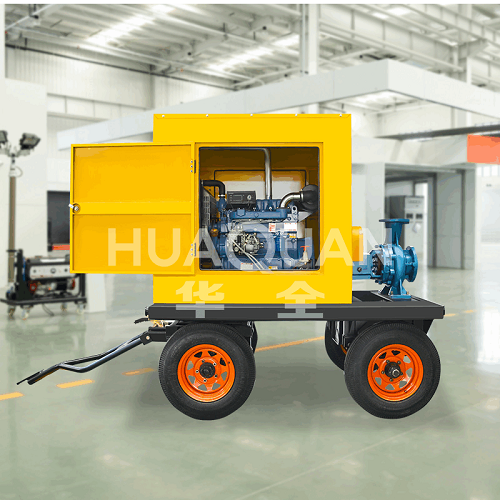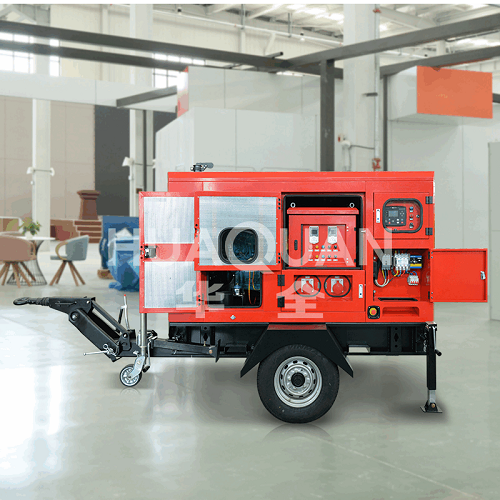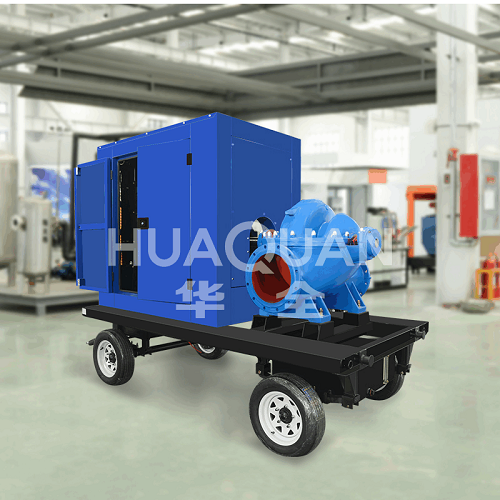When torrential rains pour down, rivers swell, and low-lying urban areas are instantly submerged in floodwaters,
flood control pumps become silent warriors in the rescue effort. Amid the roar of these steel-framed machines, accumulated waters quietly recede, homes are saved, and countless lives and property are protected by these seemingly monotonous mechanical vibrations. Flood control pumps are no ordinary equipment; their efficient operation directly impacts the timeliness and effectiveness of rescue efforts. During critical moments of flood disasters, they are a vital shield protecting lifelines.
There are many types of flood control pumps available, and choosing one that best meets local conditions will yield the best results:
1. Mobile Flood Control Pump Trucks: Integrating a diesel engine, pump, and control system onto a mobile chassis, they are highly maneuverable and ready to respond to emergencies like a "firefighter." They are ideal for rapid drainage of urban waterlogging areas and emergency drainage of embankment pipe bursts. Typical specifications: Flow rates of 1,000-5,000 m³/h, head of 15-30 meters, and built-in vacuum water diversion for rapid response.
2. Fixed drainage pump stations: Permanently installed in low-lying, flood-prone areas or near key water conservancy hubs, they serve as the cornerstone of flood control systems. They typically utilize high-flow axial flow or mixed flow pumps, offering powerful flood control and drainage capabilities. They can be equipped with multiple pump units operating in tandem, often with flow rates reaching tens or even hundreds of thousands of m³/h, forming the core of urban drainage networks.
3. Portable submersible pumps: Lightweight and easy to transport and deploy, they are particularly suitable for clearing water in confined areas such as basements, underground garages, and small farmlands. Flow rates typically range from 100-500 m³/h. While the capacity of a single unit is limited, the combined efficiency of multiple units is significant.
4. High-flow submersible electric pumps: They operate submerged in water, eliminating the need for complex water diversion and are particularly suitable for draining deepwater areas. With flow rates ranging from hundreds to thousands of m³/h, compact design, and low noise levels, it is commonly used for emergency drainage in deep foundation pits, tunnels, sunken plazas, and other locations.
Selecting a flood control pump is not a random purchase; it requires scientific consideration and alignment with actual needs:
1. Flow (Q): This core indicator refers to the amount of water pumped per unit time (m³/h). The required flow rate is determined by a comprehensive calculation based on the area of the protected area, the depth of the accumulated water, the expected water withdrawal time, and the volume of water collected. Insufficient flow will result in slow water withdrawal, delaying operations; excessive flow will waste resources.
Head (H): The total height (in meters) that the pump lifts the water body, encompassing both the actual lifting height and pipeline resistance losses. Accurately calculate the longitudinal and local head losses caused by factors such as pipeline length, number of elbows, and pipe diameter to ensure the pump head meets actual delivery requirements.
Power and Efficiency: The power source (diesel engine or electric motor) must match the pump shaft power requirements with a margin to ensure stable operation under extreme operating conditions. High-efficiency pumps are preferred for increased energy efficiency over the long term.
2. Media Characteristics: Water quality is crucial. If the water contains a lot of silt and debris (such as waterlogging on urban roads), a wear-resistant sewage pump, slurry pump, or pump with a cutting function should be selected to prevent clogging and wear. Clean water pumps are only suitable for relatively clean water.
Working Environment and Mobility: Fixed pumping stations prioritize long-term reliability and high flow rates; emergency response operations rely heavily on the rapid deployment capabilities of mobile pump trucks; and confined spaces require the flexibility of portable submersible pumps.
3. Reliability and Backup: Flood control equipment is crucial. Key pumping stations must have backup units and regularly rotate and maintain them to ensure that the system can maintain basic drainage capacity in the event of a sudden failure.
Reliable pump operation during flood control is rooted in meticulous daily maintenance and management:
1. Regular Drills and Tests: The most important thing about flood control equipment is that it should not be left idle during normal times and unused during emergencies. A regular startup and operation schedule (e.g., monthly or quarterly) must be strictly implemented, simulating actual operating conditions to verify the smoothness of the water pump's startup, operation, and shutdown processes. Important parameters such as flow, pressure, vibration, temperature, and noise must be monitored for normal operation. Diesel pumps require inspection of the starting battery, fuel system, and oil condition; electric pumps require attention to electrical insulation and control system stability.
2. Deep Maintenance of Key Components:
Power System (Diesel Engine/Motor): Replace the engine oil, oil filter, diesel filter, and air filter according to specifications. Check the coolant level and quality (for freeze and boil protection). Clean the radiator fins to ensure efficient heat dissipation. Check belt tension and wear. Test and maintain the starting battery.
Water Pump Body: Regularly inspect and replace the mechanical seal or packing seal to prevent water leakage and air ingress that could prevent pumping failure. Monitor bearing temperature and grease condition, and replenish or replace it promptly. Inspect the impeller, pump casing, and other flow-through components for wear and cavitation, repairing or replacing them as necessary.
3. Pipes and Valves: Keep pipes clear of debris. Check flange connections and hose fittings for leaks. Ensure valves (especially check valves) open and close freely and seal reliably.
Fuel and Lubrication Management: Use stabilizing additives for diesel reserves and recycle them regularly to prevent colloid precipitation from clogging the oil lines. Spare lubricants must be sealed and stored in a cool, dark place to prevent contamination and emulsification.
4. Standardized Storage: During non-flood seasons, ensure the storage environment is dry, clean, and well-ventilated. Completely drain any remaining water from the pump and cooling system to prevent freezing, cracking, or rust. Apply anti-rust grease to exposed metal parts. Disconnect the battery.
5. Recordkeeping and Information Management: Establish comprehensive equipment records, detailing every operation, maintenance, repair, and part replacement, as well as parameter changes. Leverage information technology (such as equipment management systems and IoT monitoring) to improve management efficiency and early warning capabilities.
When the flood warning alarm sounds and pumps are deployed, standardized operation and coordination are crucial:
1. Scientific Deployment, Prioritizing Location: Place the pump unit on stable, flat, elevated ground that is not easily flooded. Ensure the water inlet is completely submerged below the surface and located in a location with relatively calm water flow and minimal debris (a simple trash rack can be installed). Avoid placing the water inlet too close to the bottom to prevent the inlet from drawing in mud and sand. When parking a mobile pump truck, always apply the parking brake and secure the wheels with sleepers if necessary.
2. Pipeline connections: Prioritize smooth flow: Use drainage hoses or steel pipes of sufficient diameter. Ensure connections are secure, minimizing unnecessary bends and changes in diameter to minimize head loss. The outlet pipe should extend to a safe drainage area away from the emergency area to prevent backflow of pumped water.
3. Standardize startup and shutdown procedures for smooth transitions: Start the pump strictly in accordance with operating procedures. Diesel pumps must be idled for preheating. Ensure sufficient water priming before starting the pump (the vacuum pump priming device must operate to a stable negative pressure). For electric pumps, confirm that the voltage is stable and there are no phase losses. After starting, gradually open the outlet valve to the desired operating condition. When shutting down, slowly close the outlet valve before shutting down the power to prevent water hammer.
4. Operational Monitoring to Prevent Problems: Continuously monitor operating status: Observe flow and pressure stability; listen for abnormalities in the pump and power unit (such as sharp noises or severe vibrations); feel the bearing seat and motor housing to check for overheating; and inspect for leaks (oil, water, or gas). Immediately shut down and investigate any abnormalities.
5. Coordinated Operations to Ensure Effective Support: Large-scale drainage operations often require multiple pump units to operate in coordination or relay operations. Unify command and dispatch to clearly define the tasks of each pump (such as main pumping, backflow, and forced drainage in key areas). Ensure uninterrupted fuel/power supply (mobile power stations must be securely positioned). Deploy professional maintenance personnel and commonly used spare parts on-site to ensure that faulty equipment can be quickly repaired or replaced.
Flood control and drainage may seem mechanical, but they are crucial to the safety of the entire region. As core equipment for flood prevention and rescue operations, the value of flood control pumps lies not in their shiny new appearance but in meticulous daily maintenance. Every standardized test run, every timely filter replacement, and every meticulous lubrication of bearings lays the foundation for reliable operation in the event of a sudden flood. Behind the roar of the pumps lies the flood control personnel's reverent adherence to operating procedures and countless days and nights of repeated inspection of the equipment.



